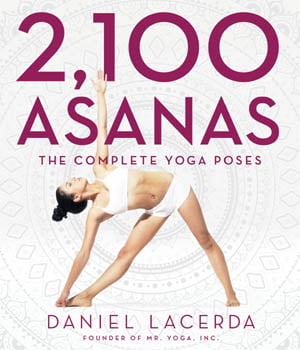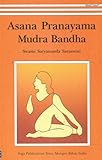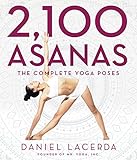2100 Asanas The Complete Yoga-Poses
2100 Asanas The Complete Yoga-Poses The ultimate goal of yoga is self-realization. You do not need to go to the mountaintop to find it or pay a teacher to show you the way. There are currencies that we exchange with one another that is much more valuable than money: kindness, selflessness, being one part of the greater good. Nor do you need to look outside yourself. If you have an open mind, a sincere desire to learn and to apply that knowledge on a daily basis, and the commitment to follow through on what you’ve begun, you can achieve self-realization.

2100 Asanas The Complete Yoga-Poses
 |
|
 |
|
 |
|
 |
|
Content
- Opening Prayer
- A Message from Mr. Yoga
- A History of Yoga
- The Eight Limbs of Yoga
- The Ujjayi Breath
- The Bandhas
- The Drishti’s
- How to Approach Yoga Poses
- Relaxation and Meditation
- A Brief Summary of Chakras
- Benefits and Cautions for 8 Conditions
- STANDING POSES
- SEATED POSES
- CORE POSES
- QUADRUPED POSES
- BACKBENDS
- ARM BALANCES
- INVERSION POSES
- PRONE POSES
- SUPINE POSES
A HISTORY OF YOGA
Most of us know yoga as a set of poses performed in a gym or yoga studio setting. The majority of yoga styles practiced today were invented in the last quarter of the 20th century and are either a far cry from yoga’s roots or have no authentic lineage.
If we really want to examine the roots of yoga, we need to go back to the Harrapan culture, dating back 3,500 years, when yoga was a meditative practice. According to some, around 1500 BCE, Harrapan culture was diminished due to the Aryan invasion. Barbarians from Normandy introduced the caste system and enforced a set of religious rituals that involved blood sacrifice practices. Along with these religious practices came sacred scriptures called the Vedas, a large body of spiritual texts originating in India. The word “yoga” was first mentioned in the oldest of the Vedas, Rig Veda. It referred to the concept of discipline.
Fast forward to 800 BCE. The Upanishads, a collection of texts that contain some of the earliest concepts of Hinduism, prescribed the method of achieving enlightenment by studying under a teacher and dedicating one’s life to a yoga practice.
The Upanishads outlined two paths to enlightenment: Karma Yoga (selfless dedication to the service of others) and Jnana Yoga (the intense study of spiritual writings). Around the 3rd century BCE, the Maitrayaniya Upanishad prescribed a six-step process to enlightenment, which included mastering pranayama (breath control), pratyahara (sense withdrawal), dhyana (meditation), Dharana (one-pointed concentration), Tarka (self-reflection), and samadhi (absolute absorption) in order to unite the Atman (individual’s spirit) and Brahman (universal spirit or source of creation). The sacred syllable om appeared in this particular Upanishad as a symbol of the union between mind and breath.
At around the same time that Maitrayaniya Upanishad was introduced, Bhagavad Gita gained prominence. This scripture combined and mythological tales that later made their way into a celebrated collection of tales, Mahabharata. Three methods of devotion were outlined in the Bhagavad Gita: Karma Yoga, Jnana Yoga, and Bhakti Yoga (devotion).
See More: Translucent skin

Disclaimer:- Dev Library is not the owner of the books and neither it create books. We just provide the links to the book for the rural and poor students who can’t afford to buy books. Those E-Books and PDFs are already available on the internet. For any reason, if someone thinks that I’m violating any laws or if anyone has any issues regarding this, please feel free to Contact Us.

Hi, I’m Dev Kirtonia, Founder & CEO of Dev Library. A website that provides all SCERT, NCERT 3 to 12, and BA, B.com, B.Sc, and Computer Science with Post Graduate Notes & Suggestions, Novel, eBooks, Biography, Quotes, Study Materials, and more.








